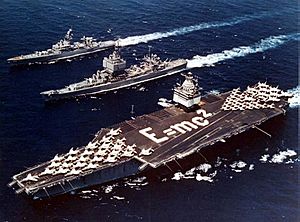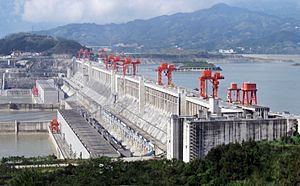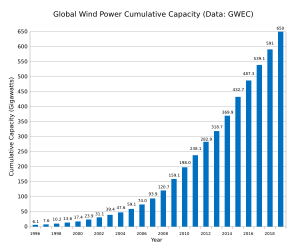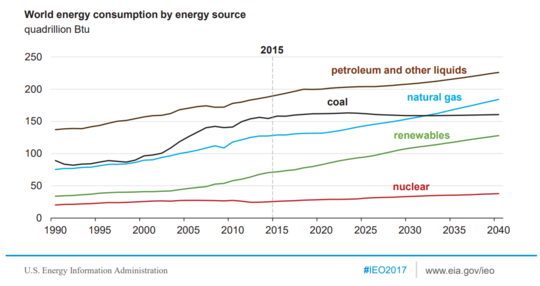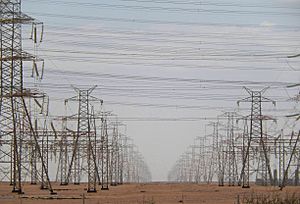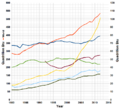Energy development facts for kids
Energy development is all about finding and using different ways to get energy from nature. This includes creating energy from renewable sources (like sun and wind), nuclear power, and fossil fuels. It also involves finding ways to reuse energy that would otherwise be wasted. When we use energy wisely and efficiently, we need less new energy, which helps the environment.
People use energy for almost everything! We need it for transportation, making things, lighting our homes, heating and cooling buildings, and communicating. Energy sources can be primary, meaning they are used as they are found, or secondary, meaning they need to be changed into a more useful form. Some energy sources are non-renewable, meaning they run out over time, while others are renewable, meaning they are naturally replaced.
Many people work in the energy industry. This includes traditional areas like oil, natural gas, electricity, and nuclear power. Newer parts of the industry focus on renewable energy, creating and selling cleaner fuels.
Contents
- How We Classify Energy Sources
- Fossil Fuels: Energy from the Past
- Nuclear Power: Splitting Atoms for Energy
- Renewable Energy: Nature's Power
- Making Energy Use More Efficient
- How Energy is Moved Around
- Storing Energy for Later
- A Brief History of Energy Use
- Our Energy Future
- Energy Technology: How We Get and Use Energy
- Images for kids
How We Classify Energy Sources
Energy sources can be grouped in different ways.
Primary and Secondary Energy
Primary energy sources are those we can use directly, without much change. Examples include wind power, solar power, wood, and fossil fuels like coal, oil, and natural gas. Secondary energy sources are created by changing a primary source. For example, electricity is a secondary energy source made from coal or wind.
Renewable and Non-Renewable Energy
Another way to classify energy is by how quickly it can be replaced. Renewable resources can recover their supply quickly enough for human needs. Think of hydroelectricity (power from water) or wind power; the wind and water cycles keep going. Non-renewable resources are used up much faster than nature can replace them. Coal, for instance, takes millions of years to form, so it's a non-renewable source.
Fossil Fuels: Energy from the Past
Fossil fuels are primary non-renewable energy sources. They come from the remains of ancient plants and animals that have been buried for millions of years. The main types are coal, petroleum (oil), and natural gas. When we burn fossil fuels, they release energy that was stored from the sun long ago. This energy can heat homes, power vehicles, or generate electricity.
Fossil fuels were very important for the Industrial Revolution in the 18th and 19th centuries. Today, they still provide most of the world's energy. They are easy to use and transport, and the technology to use them is already in place.
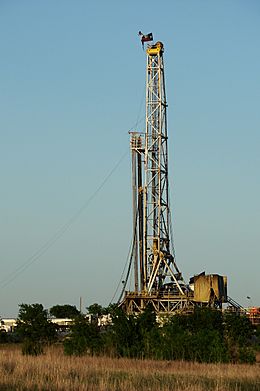
However, there are downsides. Fossil fuels are limited and will eventually run out. Getting them from the ground can also harm the environment, like strip mining for coal. Burning fossil fuels releases pollution into the air, including carbon dioxide, which is a main cause of climate change. They also release other harmful substances like sulfur dioxide and heavy metals.
Nuclear Power: Splitting Atoms for Energy
How Nuclear Fission Works
Nuclear power uses a process called nuclear fission to create heat and electricity. Fission means splitting the nucleus of an atom, usually uranium. This splitting releases a lot of energy.
Nuclear power plants provide a significant amount of the world's electricity. In 2012, they produced about 13% of global electricity. Many countries use nuclear power, and there are also many naval ships powered by nuclear reactors. Scientists are also working on nuclear fusion, which is the process that powers the Sun, but it's still a long way from being used for commercial energy.
Safety and Costs of Nuclear Power
There's a big discussion about nuclear power. Supporters say it's a safe and clean energy source that doesn't produce carbon emissions. Opponents worry about safety risks and the environmental impact.
There have been some serious nuclear power plant accidents, like Chernobyl (1986) and Fukushima (2011). However, studies show that nuclear power has caused fewer deaths per unit of energy produced compared to other major energy sources like coal or natural gas. The economic costs of nuclear accidents can be very high, and cleaning up after a meltdown can take decades.

After the Fukushima accident, some countries, like Germany, decided to close their nuclear reactors. Building new nuclear power plants is very expensive and takes a long time. These projects face financial risks because of their high upfront costs.
Despite these challenges, nuclear power is a low-carbon way to make electricity. It helps reduce greenhouse gas emissions compared to burning fossil fuels.
Renewable Energy: Nature's Power
Renewable energy comes from natural resources that are constantly replenished. These include sunlight, wind, rain, tides, waves, and geothermal heat. Renewable energy is used for electricity, heating water, heating homes, and powering vehicles.
About 16% of the world's energy comes from renewable sources. This includes traditional biomass (like wood) and hydroelectricity. Newer renewables like small hydro, modern biomass, wind, solar, and geothermal are growing very quickly. Many countries now get more than 20% of their energy from renewables. People around the world strongly support using solar and wind power.
Renewable energy sources are found all over the world, not just in a few countries. Using more renewable energy helps with energy security (meaning countries don't have to rely on others for energy), reduces climate change, and creates economic benefits. Renewable technologies are also great for rural areas and developing countries, where energy can help improve people's lives.
Hydroelectricity: Power from Water
Hydroelectricity is electricity made from the force of falling or flowing water. In 2015, hydropower generated 16.6% of the world's total electricity. It's the largest source of renewable electricity.
Hydroelectric power is produced in many countries, especially in Asia. China is the biggest producer. The cost of hydroelectricity is quite low, making it a competitive energy source. Hydro plants can also quickly adjust their power output to meet changing energy needs.
However, building dams can change river flows and harm local ecosystems. Large dams can also force people and wildlife to move. Once built, though, hydroelectric plants produce no direct waste and have very low carbon dioxide emissions compared to fossil fuel plants.
Wind Power: Harnessing the Breeze
Wind power uses wind turbines to capture the energy of the wind. The wind spins the blades, which turn magnets to create electricity. Wind turbines are often grouped together in wind farms, both on land and offshore. Global wind power has grown very fast, providing about 4% of worldwide electricity and increasing rapidly.
Wind power is widely used in Europe, Asia, and the United States. Some countries, like Denmark, get a large portion of their electricity from wind. By 2011, 83 countries were using wind power commercially.
| Wind farm | Current capacity (MW) |
Country | Notes | ||||
|---|---|---|---|---|---|---|---|
| Alta (Oak Creek-Mojave) | 1,320 | ||||||
| Jaisalmer Wind Park | 1,064 | ||||||
| Roscoe Wind Farm | 781 | ||||||
| Horse Hollow Wind Energy Center | 735 | ||||||
| Capricorn Ridge Wind Farm | 662 | ||||||
| Fântânele-Cogealac Wind Farm | 600 | Fowler Ridge Wind Farm | 599 |
Solar Power: Energy from the Sun
Solar energy is power from the sun's light and heat. It's a clean, renewable source that can be used in many ways. Solar technologies can convert sunlight directly into electricity using solar panels (PV), or they can use the sun's heat for hot water or heating buildings.
Solar power is becoming more and more popular because it's environmentally friendly and the cost of solar technology is decreasing. Many homes and businesses now have solar panels on their roofs. Large solar farms are also being built to generate electricity for entire communities.
Biofuels: Energy from Living Things

Biofuels are fuels made from recently living organisms, usually plants. This energy comes from carbon fixation, a process where plants absorb carbon dioxide. Biomass (plant material) can be changed into solid, liquid, or gas fuels. Biofuels have become more popular as oil prices rise and countries look for more secure energy sources.
Bioethanol is an alcohol made by fermenting sugar or starch crops like corn or sugarcane. It can be used as fuel for vehicles, often mixed with gasoline. Biodiesel is made from vegetable oils and animal fats. It can be used in diesel engines, often mixed with regular diesel fuel to reduce pollution.
In 2010, global biofuel production reached 105 billion liters, making up 2.7% of the world's road transport fuels. The United States and Brazil are the top producers of ethanol, while the European Union leads in biodiesel production. The International Energy Agency hopes biofuels can provide more than a quarter of the world's transportation fuels by 2050.
Geothermal Energy: Earth's Inner Heat
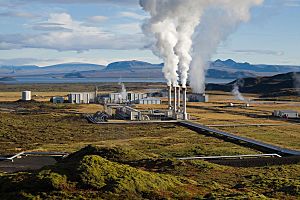
Geothermal energy is heat from inside the Earth. This heat comes from the planet's formation and from the natural decay of radioactive minerals deep underground. The Earth's core is very hot, and this heat continuously moves towards the surface.
People have used geothermal energy from hot springs for bathing for thousands of years and for heating homes since ancient Roman times. Today, it's also used to generate electricity. In 2012, 24 countries had 11,400 megawatts of geothermal power online. Geothermal heat is also used directly for heating buildings, spas, and industrial processes.
Geothermal power is reliable, sustainable, and good for the environment. It traditionally works best near tectonic plate boundaries where the Earth's heat is closer to the surface. However, new technologies are expanding where it can be used. Geothermal wells release some greenhouse gases, but far less than fossil fuels. This means geothermal power can help reduce global warming.
Oceanic Energy: Power from the Seas
Marine energy (or ocean energy) is the energy found in ocean waves, tides, and differences in ocean temperature. The constant movement of water in the oceans holds a huge amount of energy. This energy can be captured to generate electricity for homes, transport, and industries.
Marine energy includes both wave power (from surface waves) and tidal power (from the movement of large bodies of water). It's important to note that offshore wind power is not marine energy, as it comes from the wind, even if the turbines are in the water. Oceans are a massive source of energy and are located near many large populations, making them a promising source of new renewable energy worldwide.
The Goal of 100% Renewable Energy
Many people believe it's possible and important to switch to 100% renewable energy for electricity, transport, and even all our energy needs globally. This idea is driven by concerns about global warming and the environment, as well as economic benefits.
Experts say there are few major technical barriers to using a mix of renewable energy technologies to meet most of the world's energy demand. Some researchers believe that by 2030, all new energy could come from wind power, solar power, and hydropower, and that existing energy systems could be replaced by 2050. They argue that the main challenges are social and political, not technological or economic.
Making Energy Use More Efficient
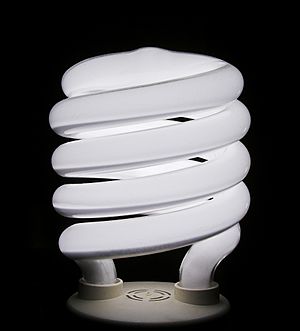
While it's not about creating new energy, making our energy use more efficient is a big part of energy development. It means we need less energy to do the same amount of work. For example, insulating a home means it needs less heating or cooling. Using compact fluorescent lamps (CFLs) or LED lights uses much less energy than old incandescent bulbs. CFLs use two-thirds less energy and last much longer.
Using energy more efficiently can save money because you pay less for energy. It also reduces pollution. The International Energy Agency believes that improving energy efficiency in buildings, factories, and transportation could significantly reduce global energy demand by 2050, even as the world economy and population grow.
Energy efficiency and renewable energy are often called the "twin pillars" of a sustainable energy plan. For many countries, energy efficiency also helps with national security by reducing the need to import energy from other countries.
How Energy is Moved Around
New energy sources are rare, but the ways we move energy around are always improving.
Shipping and Pipelines

Coal, oil, and their products are moved by boats, trains, or trucks. Oil and natural gas can also travel through pipelines. Fuels like gasoline can even be delivered by aircraft. Pipelines for natural gas need to keep a certain pressure to work correctly.
Wired Energy Transfer: The Electrical Grid

Electrical grids are networks of wires and equipment that move electricity from where it's made (like a power plant) to where it's used (like your home), sometimes hundreds of kilometers away. They use substations and transmission lines to keep electricity flowing steadily.
Grids can have problems like blackouts (total power loss) or brownouts (reduced power), often due to bad weather. Strong solar storms can also affect transmissions. Grids have a limit to how much power they can carry. If too much power is needed, failures can happen, so power might be rationed.
Countries like Canada, the U.S., and Australia use a lot of electricity because they have widespread electrical networks. The U.S. grid is very advanced, but keeping it maintained is a challenge.
Wireless Energy Transfer
Wireless power transfer means sending electrical energy from a source to a device without using wires. Right now, this technology works only for short distances and low power levels.
Some scientists imagine orbiting solar power collectors that would send solar energy to Earth wirelessly using microwave beams. This idea faces big technical challenges to make it safe and affordable.
Storing Energy for Later
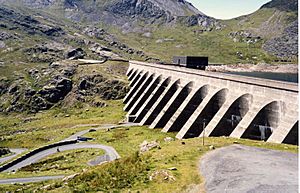
Energy storage is about keeping energy to use later. A device that stores energy is sometimes called an accumulator.
Energy can be stored in many forms, like potential energy (stored in a battery or a dam) or kinetic energy (energy of motion). Some storage methods are for short periods, like batteries for phones. Others can store energy for a long time, like turning electricity into hydrogen gas or storing heat underground between seasons.
Fossil fuels like coal and gasoline are also forms of stored energy, created from ancient sunlight captured by plants. Even the food we eat is stored chemical energy!
A Brief History of Energy Use
Since ancient times, when people discovered fire, humans have always looked for ways to get and use energy. From windmills in the Middle Ages to splitting atoms for electricity today, our search for energy never stops.
Most energy sources (except nuclear, geothermal, and tidal) come from the sun's current energy or from ancient plants and animals that used sunlight. Ultimately, even the sun's energy comes from nuclear fusion. Geothermal power comes from radioactive materials deep inside the Earth, and nuclear fission uses heavy radioactive elements found in the Earth's crust.
Since the Industrial Revolution, people have wondered about future energy supplies. In 1865, William Stanley Jevons wrote about coal running out. Today, with growing global energy demand, we need to use many different energy sources. Energy conservation (using energy efficiently) is also key, as it reduces our overall energy needs.
Sustainable Energy for the Future
The environmental movement stresses the importance of sustainable energy. Renewable energy is sustainable because its supply won't run out for millions or billions of years. "Sustainability" also means the environment can handle the waste products, especially air pollution. Sources like wind, solar, and hydropower produce no direct waste.
Energy Resilience
Some experts talk about "energy resilience" instead of "energy independence." Energy resilience means being able to handle interruptions in energy supply. This often involves having a diverse energy supply, so if one source has a problem, others can make up for it. For example, if a country uses electricity for many things, and that electricity can come from various sources, it's more resilient.
Our Energy Future
Looking ahead, we have choices for our energy future. Many models help us understand different strategies to achieve rapid and sustainable development. We also worry about short-term energy crises.
Producing energy usually requires energy itself. Drilling for oil or building a wind farm takes energy. The fossil fuels left are often harder to get, meaning they require more energy to extract. If it takes more energy to get a resource than the energy it provides, it's no longer an effective energy source. New technology can help reduce the energy needed to extract resources.
Some believe that a sustainable energy future could involve buildings, vehicles, and roads using artificial photosynthesis to create hydrogen and absorb carbon dioxide, much like plants do.
Scientists are also looking into space-based solar power, where solar collectors in space would send energy to Earth. This could provide very intense light and wouldn't be affected by weather.
Energy Technology: How We Get and Use Energy
Energy technology is an important field that focuses on getting, changing, moving, storing, and using energy in ways that are efficient, safe, environmentally friendly, and affordable. The goal is to get a lot of energy without harming people, nature, or the environment.
Energy is a basic need for people, and because it's a limited resource, it has sometimes led to conflicts. Getting and using energy can also affect local environments and even have global impacts.
Energy is the ability to do work. We get energy from food, and it comes in many forms like kinetic (motion), potential (stored), heat, and light. We need energy for lighting, heating, cooking, running industries, and transportation. Energy sources are generally divided into two types:
- Renewable Energy Sources
- Non-Renewable Energy Sources
Different Fields in Energy Technology
Energy technology connects with many other areas of science and engineering:
- Physics: For understanding how energy changes (thermodynamics) and nuclear power.
- Chemistry: For fuels, burning, air pollution, batteries, and fuel cells.
- Electrical engineering: For producing and using electricity.
- Engineering: For machines like engines, turbines, and pumps.
- Geography: For finding geothermal energy and other resources.
- Mining: For fossil fuels.
- Agriculture and forestry: For renewable energy sources like biomass.
- Meteorology: For understanding wind and solar energy.
- Water and Waterways: For hydropower.
- Waste management: For dealing with environmental impacts.
- Transportation: For designing energy-saving transport systems.
- Environmental studies: For looking at how energy use affects the environment and climate change.
Electrical Engineering
Electric power engineering focuses on making and using electricity. This includes studying generators, electric motors, and transformers. It also involves the infrastructure like substations, power lines, and cables. Managing how electricity flows through networks is key to being energy efficient.
Thermodynamics
Thermodynamics is a branch of physics that deals with the basic rules of how energy changes from one form to another.
Thermal and Chemical Energy
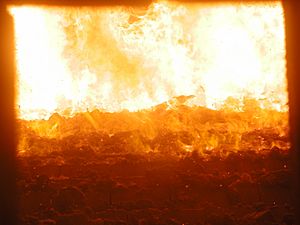
Thermal and chemical energy are linked to chemistry and environmental studies. This area looks at how things burn in engines and incinerators, focusing on efficiency, pollution, and safety. Technologies that clean exhaust gases help reduce air pollution. Boiler technology deals with designing and operating steam boilers and turbines, which are used in power plants.
Energy conversion is about how engines, turbines, and pumps change energy for transportation, mechanical work, and power generation.
Nuclear Energy
Nuclear technology deals with producing nuclear power from nuclear reactors, processing nuclear fuel, and safely disposing of radioactive waste. It uses knowledge from nuclear physics and chemistry.
Nuclear power is important worldwide for electricity. Scientists are also researching fusion technology, hoping it might one day replace fission reactors.
Renewable Energy Technologies
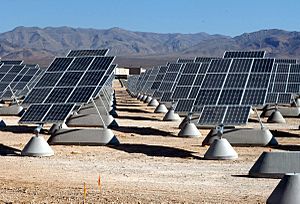
Renewable energy has many different technologies.
Wind Power Technology
Wind turbines turn wind energy into electricity. They use aerodynamics to capture wind, which spins the blades and then a generator. Wind power is becoming very important because it's efficient and doesn't use water, making it good for dry areas.
Geothermal Technology
Deep inside the Earth, hot molten rock called magma heats groundwater. Technologies like power plants (dry, flash, or binary) use this hot water or steam to spin turbines connected to generators, producing electricity. Newer systems use shallow loops to pump heat to and from buildings, taking advantage of the Earth's constant underground temperature.
Hydropower Technology
Hydropower gets mechanical energy from rivers, ocean waves, and tides. Civil engineering is used to build dams, tunnels, and waterways. A water turbine spun by flowing water powers an electrical generator to make electricity.
Bioenergy Technology
Bioenergy deals with growing, processing, and using biomass (plant material) to create fuel for power plants. This can include making ethanol, methanol, or hydrogen for fuel cells, which can then generate electricity.
Enabling Technologies
Heat pumps and Thermal energy storage are technologies that help us use renewable energy sources that might otherwise be too cool or not available when needed. Heat pumps can raise the temperature of renewable heat sources and use electricity to extract more energy from low-quality sources like seawater or waste heat.
Thermal storage allows heat or cold to be stored for hours, overnight, or even between seasons. This can involve changing the temperature of a material or using phase changes (like water turning to ice). Short-term storage can help manage energy demand peaks. These technologies allow us to use natural energy (from solar collectors or winter cold), waste energy (from industries), or surplus energy (from wind farms when it's very windy). For example, the Drake Landing Solar Community in Canada gets 97% of its year-round heat from solar collectors, storing most of the heat collected in summer.
Images for kids
-
Information on pump regarding ethanol fuel blend up to 10%, California.




